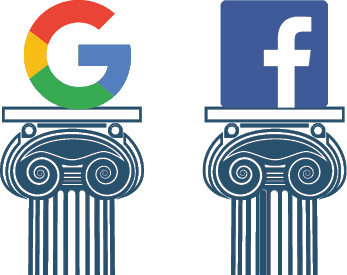Your mobile strategy shouldn’t be set in stone. This might be a little shocking to hear, but it’s true: your customers’ needs and behaviors are ever-changing, which means strategies and goals that you set at the beginning of this year won’t necessarily match up with what your customers want and need come July. So, while your mobile strategy shouldn’t be set in stone, it should definitely be taking shape based on some very telling trends. Here are a few trends and insights for you to consider as you evolve your mobile strategy.
The Current State of Mobile
We’ll start with the obvious: consumers are mobile-obsessed. We really don’t have to look much further than our own habits to confirm this is true; we’re shopping on mobile, searching on mobile, and turning to mobile in our moments of need. Seventy-one percent of overall digital minutes are spent on mobile1–and don’t buy into the myth that it’s just millennials. They surely lead the pack at 93 percent smartphone penetration in the U.S., but GenX-ers follow closely behind at 85 percent2, proving that brands need to provide a mobile touchpoint in order to win in customer experience.
Mobile Apps
Mobile Apps
So, we know consumers are on their phones now more than ever, but what exactly is capturing their attention? Over a decade after their inception, it’s still mobile apps. They account for 57 percent of all digital minutes in the U.S.1, which isn’t surprising considering most of the apps that earn our home screen real estate are ones that we turn to daily. In fact, out of all the time consumers spend in apps, 90 percent of that time is spent within their top five apps.3 While our top mobile apps are still capturing our time and attention, where does that leave the more than 2 billion other apps?4 For many of these apps (quite a few of them from businesses trying to capitalize on their customers’ growing mobile appetites), the outlook is grim; Fifty percent of smartphone users reported downloading zero new apps per month1, because that cumbersome download and update process just isn’t worth it.

Mobile Web
Mobile Web
Mobile-friendly websites were all the rage until the app craze settled in. But consider this trend a bit of a boomerang effect–we ran hard and fast with apps, until we realized the web could help us cast a wider net, with search engines and no need to download anything. So here we are, turning back to the mobile web for quick help in our moments of need. In fact, Google was so confident that mobile would overtake desktop search traffic that in 2016, they announced that websites would be indexed for search based on their mobile sites–not desktop.5 This change means that in order to index well on searches, mobile sites–at the bare minimum–have to: load quickly; correctly place photos, text, and buttons; and stack correctly for mobile screens without the need to zoom or scroll horizontally. Not only was this change a great indication that the mobile-first generation is upon us, but it’s also telling of the growing consumer need for immediacy in their mobile-based experiences–and even further, their need for truly mobile-first design.

Mobile Advertising
Mobile Advertising
Google and Facebook. They’re the powerful duopoly that own eight of the ten top apps on the app store today3, and they’re also the largest players in the advertising platform space. So it shouldn’t come as any surprise that digital advertising is taking mobile by storm. More than half of digital advertising is spent on mobile (spending on mobile advertising surged 77 percent to $36.6 billion last year).6 David Doty, executive vice president and CMO at IAB, told the Wall Street Journal: “Brand dollars naturally follow consumers, and you’re starting to see a mobile-first, and sometimes a mobile-only mindset among marketers.”6

SMS/MMS Marketing
SMS/MMS Marketing
A few years back, marketers leaned heavily into mobile apps over SMS as a brand-to-consumer communication channel, thinking that richer functionality of a native mobile app would draw in the consumer more. But the tide is shifting, and the here-and-now generation that is tired of waiting on hold with support lines is also tiring of the native app download and update process. Millennials are driving SMS back to the top, with 60 percent of them preferring two-way text engagement with companies because of its convenience, speed, and ease.7 And it’s not just millennials–the average American (of any age) makes or answers six phone calls per day, and sends or receives at least 32 texts.8

Trends to Watch
A successful mobile strategy is two-pronged: it has to, first and foremost, take into account what your customer needs, and when they’ll need it in terms of their journey with your brand; then, it has to implement future-facing technologies that will ultimately help meet those customer needs. It’s a two way street; you need both customer-centric goals and mobile-centric technologies to truly deliver. That’s why we’ve boiled down some of the major trends in both consumer behaviors and technological advances that will help get you on the right track for your ever-evolving mobile strategy.
Transition to Progressive Web Apps
Transition to Progressive Web Apps
Progressive Web Apps (PWAs) are web-based experiences that meet specific technical and user experience guidelines set by Google. They’re lightning fast, super secure, and easily accessible, making them the ultimate mobile touchpoint for your customers. According to Gartner, PWAs will replace 50 percent of general-purpose, consumer-facing mobile apps by 20209, which isn’t surprising considering some major brands are already diving in head first. Starbucks launched their PWA in mid-2017 to supplement their already well-loved native mobile app, and so far it’s been a hit–functioning just like the native app, but quicker, and taking up far less storage space. And, beauty brand Lancome built a PWA in 2016 that has already yielded a 51 percent increase in mobile sessions, and a 17 percent increase in overall conversions.10 With big brands leading the way in transitioning their moment-of-need experiences to PWAs, you should consider following suit in order to satisfy your need-it-now customers.

Mixing the Physical and Digital Worlds with AR
One of the biggest mobile tech stories of the past year was Apple’s launch of the ARKit platform, which finally put the power to build augmented reality (AR) experiences into the hands of brands everywhere.11 It’s been a quick transition, but with tech giants like Snapchat, Amazon, and Facebook proliferating new technologies like AR, artificial intelligence (AI), and voice command, consumers now expect the digital world to seamlessly mesh with the physical world around them. Experts predict that AR and virtual reality (VR) will generate $67.3 billion in revenue by 202112, which means businesses that are starting to invest in these technologies now will surely see large returns in the near future. Don’t be afraid to think big with how you can implement AR in your marketing strategies–ARKit is making it easier than ever to make those big dreams an augmented reality.
An Out-Of This World AR Use Case
The Star Wars brand put on an AR-based scavenger hunt last year that drove shoppers into big box stores and straight to their merchandise displays, and furniture brand Ikea provides its consumers with an AR experience that virtually places to-scale pieces of furniture in their homes, giving them the ability to take multiple pieces of furniture for a “test drive” before making the big purchase, and decreasing their chances of product returns.
Embracing Voice-Command As A Jumping Point
We’ve all met Alexa, and she’s changing not only the way we live, but the way we browse the internet. It may seem futuristic to think that browsing the internet doesn’t require a screen, but you’re already doing it every time you ask Alexa what the weather will be like this weekend, or how long it will take you to get to work today. Gartner sees this trend continuing, predicting that 30 percent of browsing sessions will be screenless by 2020.13 What does this mean for your brand? It means it’s time to embrace mobile as the assistant to their assistant–providing ways for voice assistants to pull up information automatically on their phone as they browse with their voice. So for example, if you ask Alexa how to make chocolate chip cookies, it’s not too far off to hope that Alexa could prompt your phone to pull up the recipe on your phone without a single tap. With that in mind, brands need to be prepared to create made-for-mobile experiences that don’t require a download, so that when customers ask, you can answer.
The Future of Mobile: Cloud-Based Mobile Apps
The Trend: Users aren’t downloading native apps unless they plan on using them daily.
The Solution: Cloud-based mobile apps. They provide the rich, made-for-mobile functionality that we’ve come to know and love about native mobile apps, but increase adoption by eliminating the cumbersome app store download and update process, allowing you to employ smart activation methods like text, QR codes, and near field communication (NFC). And, when you build cloud-based mobile apps, you can leverage location and user-based data to ensure a highly personalized experience that will travel with your customer throughout their entire journey with your brand.
Consumers Craving Personalization
In 2015, Google noted a staggering growth in “near me” searches. Then, just two years later, something interesting happened: people were still searching for location-based services, but dropping the “near me” qualifier, because they already assumed that the results would be personalized based on their location.14 Consumers are now assuming their search experiences will be personalized, and that goes for their mobile touchpoints with brands, too. Eighty-three percent of customers say they would have a more positive view of a brand that delivered personalized loyalty messaging, and three-fourths of consumers ranked transactional messages (text alerts with updates on orders, etc.) as among their top reasons for opting into notifications.15 We recommend utilizing all of that consumer data you’ve been gathering to start personalizing your customer experience on mobile, and offering a way for your customers to opt-in for their preferred method of communication with your brand–whether that be via text, email, or chat.
Implementing Customer-facing AI
Implementing Customer-facing AI
AI is more than robots and machine learning–it’s a powerful tool for creating 1:1 relationships with your customers. Brands today are already implementing AI-powered chatbots that allow customers to text with a brand instead of requiring a frustrating call to a support line. By leveraging data they already have on the customer and allowing these bots to learn as they chat, customers may even end up getting an even more personalized experience with a chatbot than they would talking to real human! It’s not such a far off vision, with Gartner predicting that by 2020, these “smart agent” chatbots will manage 40 percent of mobile interactions, and even sooner begin recognizing customers by face and voice across different channels.16

Take Your Mobile Strategy to the Next Level
Now that you know mobile’s present realities, its future implications, and the trends surrounding consumer behaviors and mobile technologies, it’s time to take out that mobile strategy and take a second look. Here are our recommendations for taking your mobile strategy to the next level:
Here's how you can take your mobile marketing strategy to the next level:
- Start Mobile First
- Stop Building Native Mobile Apps
- Make the Journey Mobile
- Text With Your Customers
- Make It Personal
Start Mobile First
Start Mobile First
We’ve had many “mobile-first” false alarms. But this time, it’s for real. Desktop web views are on the decline, and it’s clear that consumers are reaching for their mobile devices more than their laptops (Mobile users overtook desktop in 2014 and the growth of mobile and decline of desktop hasn’t slowed since). So, stop designing your website for desktop and then thinking about how that will transition to mobile. Instead, start with designing the mobile experience first, and think about the desktop design second. Even if you’ve already got a mobile-friendly website that was designed with a desktop-first mindset, it’s never too late to revisit and redesign.

Stop Building Native Mobile Apps
Stop Building Native Mobile Apps
If you’re not Facebook, Google, or a gaming app then you should never build a native mobile app again. Yes, you heard us right: You should NEVER build a native mobile app again. Let that sink in for a minute. It’s likely counterintuitive to everything you've known about mobile since the app store was first launched in 2007, but it's the truth. Your brand doesn't need a native mobile app anymore. Instead you need to transition to cloud-based mobile apps in order to meet your “need-it-now” customers with rich, mobile experiences that ditch the download.

Make The Journey Mobile
Make The Journey Mobile
Get out your customer journey map (assuming you have one...if not, create one ASAP!), and start figuring out how mobile can infiltrate every single aspect of it. Mobile should be a linchpin of your customer journey, not an afterthought. Start with just one moment, then think of everything your customer could possibly need in that moment, and put it all in one, easy-to-access mobile experience. Need inspiration? Look no further than Apple’s iMessage, which recently integrated payment capabilities, song-sharing platforms, multimedia searches, and more–all within the application. This means their users can access rich, cross-functional capabilities that enhance their experience, all without ever having to leave iMessage.

Text with Your Customers
Text with Your Customers
The millennials have spoken...actually, they’ve texted. The most mobile-savvy generation yet would much rather text than talk, which gives you the perfect opportunity to connect with consumers via text. When they complete a purchase online, allow them to opt-in for text notifications that will update them on their delivery status, then when the package delivery is confirmed, prompt them again to opt-in for support and maintenance reminders. If it’s not possible to migrate your support teams or marketing communications over to a texting platform, consider exploring chatbots as an option.

Make It Personal
Make It Personal
Mobile hasn’t seen the level of personalization that all other marketing channels have seen over the years. You may have a slightly personalized mobile-friendly website, but it’s highly unlikely that your entire mobile experience is personalized to your customer. It’s time to change that. Make mobile evolve with your customer based on what you know about them. This means dusting off that data you’ve collected and putting it to good use–enabling you to provide highly-personalized mobile experience that dynamically changing throughout their journey with your brand, without ever asking your customer to download an app ever again.

It's Time to Take Action
With shifting consumer behaviors and new technologies emerging quicker than ever before, your mobile strategy can no longer be something that you set and forget; It needs to evolve with your customers’ needs. Because if it doesn’t evolve, then your brand will get left behind.